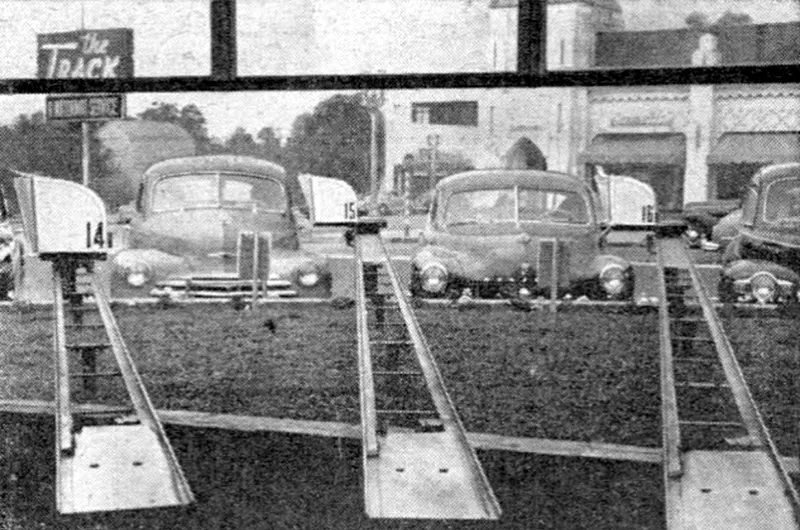In the post-war years, Los Angeles experienced a flourishing car culture, accompanied by a surge in innovations tailored to an automobile-centered way of life.Southern California particularly became synonymous with drive-thru restaurants, drive-in eateries, and drive-in theaters, embodying the spirit of convenience and modernity.
Among these innovative concepts, the “Motormat” drive-in holds a distinct place. It aligns with the unique trends of its era, where the car was not merely a mode of transportation, but a lifestyle symbol.
Pioneered by Kenneth C. Purdy in 1948 and patented as the Motormat, this ingenious concept aimed to streamline drive-in dining by introducing a conveyor belt system for both order placement and food delivery.
One notable adopter of this innovative approach was the Track restaurant in Southern California, where a circular arrangement of 20 stalls encircled a central building.
 Instead of carhops, a metal bin on a conveyor belt assumed multiple roles – waiter, busboy, and server. Purdy, in 1949, highlighted that this innovation shaved off 30 to 50% of the usual drive-in time.
Instead of carhops, a metal bin on a conveyor belt assumed multiple roles – waiter, busboy, and server. Purdy, in 1949, highlighted that this innovation shaved off 30 to 50% of the usual drive-in time.
The Motormat eliminated the wait for carhops, mitigated the challenge of dusty food, negated the need to signal for the check, and eradicated waiting for change.
At the drive-in, the ordering process was elegantly simple. Pulling up to a window-height bin mounted on rails, customers discovered water glasses, a menu, a pencil, and a pad inside.
They would fill out their order, push a button, and send the bin back to the kitchen, located at the center of the circular structure.
While the food was being prepared, the bin would return with the bill. Once settled, the food and change would be sent back down the rails.
 Here’s a description of the operation from The American Drive-In, by Michael Karl Witzel:
Here’s a description of the operation from The American Drive-In, by Michael Karl Witzel:
“Debuted in 1949, a Los Angeles innovation promised total elimination of carhops. At a new drive-in called “The Track,” it attracted customers from as far as Santa Monica with its unique type of service.
Like a group of horses at a trough , cars ringed around a central building, forming a circular pattern. Twenty semicircular parking spaces bridged a center kitchen by means of metal tracks.
Food and condiments rode the rails within carrying… compartments each powered by a small half-horsepower motor.
“The mechanical setup was reminiscent of the wackiest Rube Goldberg device. Positioned in a predetermined parking space, the diner rolled down the car window and was greeted by a stainless-steel bin that could be made flush with the door.
Inside the box were plastic cups, a water bottle, a menu, an order pad, and a change tray. It was large, too. Food for six people could be ferried back and forth on the elevated platforms.
Patrons would jot down their orders and with the push of a button, the unit scotted a return to the kitchen.
“When the empty bin arrived at the kitchen, an attendant put through the order and added up the bill. As hamburgers and other entrées were prepared, the rail box made its second journey to the automobile to collect the money.
By the time it returned to the preparation area, the food was ready to go–loaded into the compartment along with condiments and the customer’s change.
According to inventor Kenneth C. Purdy, the spoke-and-wheel-track arrangement sped service 20-25 percent.”
 While met with initial enthusiasm, The Track restaurant encountered hurdles in supplanting traditional skating carhops.
While met with initial enthusiasm, The Track restaurant encountered hurdles in supplanting traditional skating carhops.
Despite notable achievements, such as selling 3,000 meals on its inauguration day and serving nearly 40,000 patrons within the first two weeks, the Motormat concept did not become widespread.
By 1950, the Motormat automated drive-in venture expanded to three establishments across the Los Angeles region, but eventually, all had ceased operations by 1952.
Factors such as maintenance, technical issues, and customer preferences played a role in the concept’s fading popularity.
Ultimately, while the “Motormat” offered a glimpse of the future, it encountered practical hurdles that hindered its long-term success.




The view from the kitchen.

Assuming that the contraption made it out to his car, the driver received his order in this box.

(Photo credit: Flickr / Wikimedia Commons / Pinterest).





